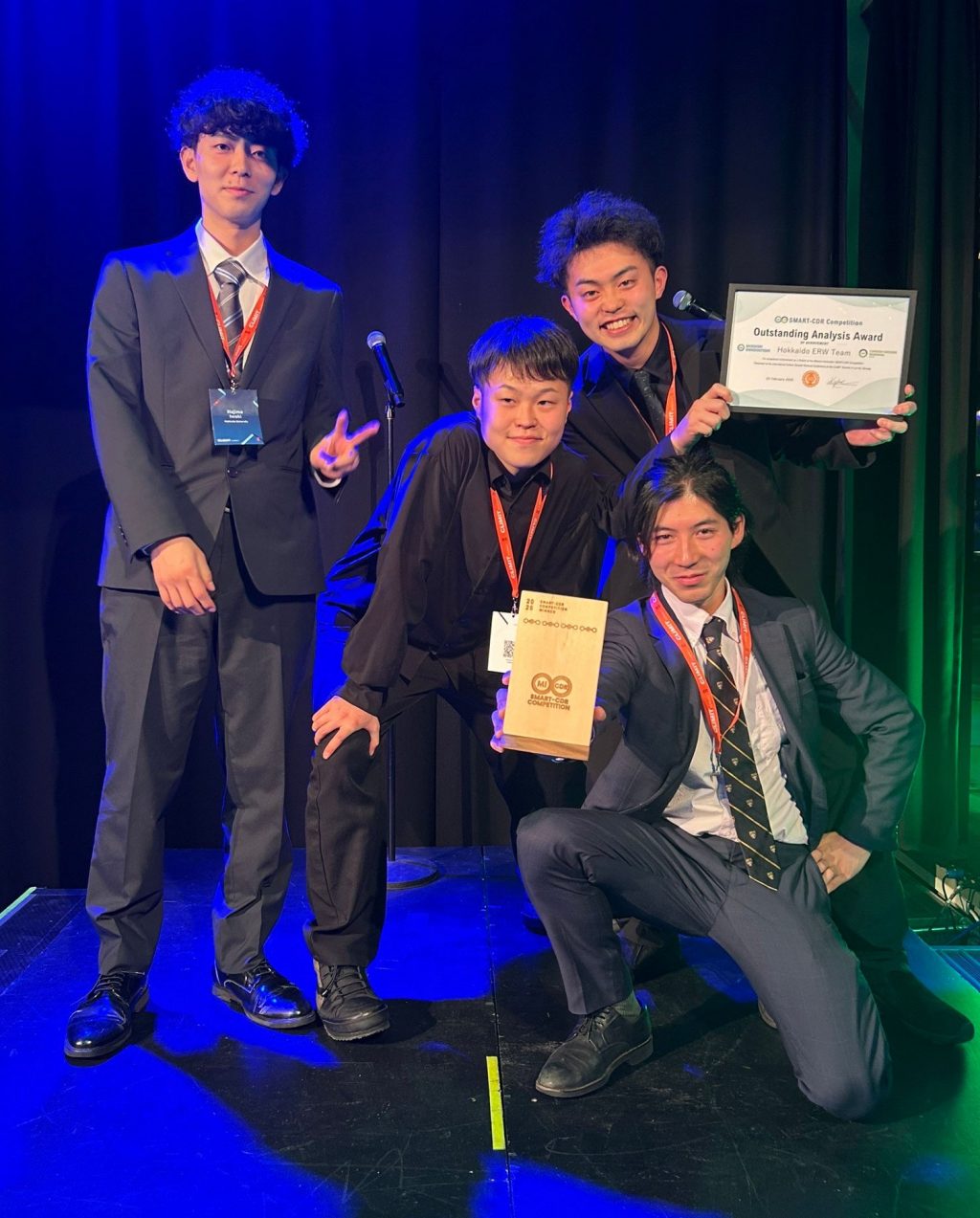Members of Hokkaido University ERW: Hajime Iwaki (left), Ryoya Sato (middle), Masaki Takeda (right-top), and Fugo Nakamura (right-bottom). Photo provided by Hokkaido University ERW.
Fugo Nakamura (M1), Masaki Takeda (B4), Ryoya Sato (B4), and Hajime Iwaki (B4), from the Laboratory of Eco-Materials and Resources, Division of Sustainable Resources Engineering (School of Engineering and Graduate School of Engineering), competed as a team “Hokkaido University ERW” and secured a top position alongside two other finalist teams in the international competition, “Student Monitoring and Reporting Technology for Carbon Dioxide Removal (SMART CDR),” held in Norway from February 25–27, 2025. The team is taking home a USD $10,000 cash prize for their outstanding achievement.
Team Hokkaido University ERW was one of six finalists selected from 24 university teams representing 10 countries during the semifinals last October. Another finalist from Hokkaido University, Team ERW Seekers from the School of Agriculture, also secured a spot in the finals, but only Hokkaido University ERW managed to secure a place within the top three.
Both teams are part of the same national project, “Advanced Enhanced Rock Weathering (A-ERW) Technology Actively Combined with Site Characteristics,” under the Moonshot Research and Development Program of the Japanese government. With guidance from global experts, the teams further developed and refined their solutions in preparation for the competition’s final stage.
The SMART CDR Competition is a global innovation challenge launched by the Carbon Dioxide Removal (CDR) Mission, a coalition of nine governments working together to accelerate CDR innovation. The competition invites university students worldwide to develop cutting-edge Monitoring, Reporting, and Verification (MRV) solutions for carbon removal technologies.
In Norway, the team presented a simple and cost-effective MRV technology that enhances natural rock weathering to remove CO₂ from the atmosphere while improving soil and water quality. Their approach—applying basalt to acid mine drainage areas—accelerates rock weathering up to 1,000 times faster than in croplands, significantly increasing CO₂ removal.
A key strength of the solution is its co-benefit of water purification, as the method removes heavy metals and helps mitigate ocean acidification. Another advantage is their simplified yet precise approach to quantifying CO₂ removal, ensuring reliability without the need for costly extreme accuracy.
We talked to the team about their experience and key takeaways from the competition.
Q. What was your experience like competing in an international challenge?
We’re working on a niche approach to carbon dioxide removal called ‘enhanced rock weathering using acid mine drainage.‘ As we learned more about this emerging and still relatively unexplored technology, we kept discovering more and more benefits. But at the same time, we realized that being so deeply focused on it had made us blind to the bigger picture.
Participating in this international competition gave us the chance to discuss our work with students, researchers, and business professionals from Europe, the U.S., and the Middle East who share the same goals. These conversations broadened our perspective, helping us discover new angles to explore while also making it clearer what challenges need to be addressed before commercialization.
We also learned that some ideas that seem minor in Japan are actually widely recognized and applied internationally. This experience really drove home the importance of thinking globally and looking at our research in a broader context.
Q. Do you plan to further develop and implement your solution?
Yes, we plan to launch a startup to help promote and scale this carbon removal technology. Through the competition, we learned that many of the other teams were already working at startups developing similar technologies, which made us realize the high level of expertise in this field globally. This experience inspired us to shape our own research into a concrete solution that can help address real-world challenges.
This latest achievement builds on the team’s continued success, with three of its members— Fugo Nakamura, Masaki Takeda, Ryoya Sato—earning recognition for presenting their carbon dioxide removal technology at two other competitions in recent months:
Hokkaido Society 5.0 Future Creation Workshop (held in Sapporo on September 20, 2024) – second place.
DXCUP2024 Winter (held in Mongolia on December 7, 2024) – third place.
Congratulations to team Hokkaido University ERW!
Names, year of study, and affiliations are at the time of the interview.


